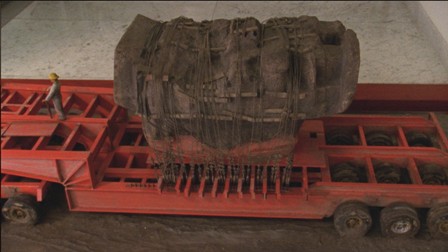



La piedra ausente
The Absent Stone
Tipo de producción/Type of Production
Documental/Documentary
Año de producción/Production Year
2013
País/Country
México-EUA
Duración/Running time
80 min.
Producción/Production
Dirección/Director
Sandra Rozental, Jesse Lerner
Producción/Producer
Sandra Rozental, Jesse Lerner
Guion/Screenplay
Sandra Rozental
Fotografía/Cinematography
Jesse Lerner
Edición/Editing
Jesse Lerner
Sonido/Sound
Michael Kowalski y Sara Harris
Música/Music
José Chavarría
Sandra Rozental, Jesse Lerner
Producción/Producer
Sandra Rozental, Jesse Lerner
Guion/Screenplay
Sandra Rozental
Fotografía/Cinematography
Jesse Lerner
Edición/Editing
Jesse Lerner
Sonido/Sound
Michael Kowalski y Sara Harris
Música/Music
José Chavarría
Sinopsis/Synopsis
En 1964, un enorme monolito prehispánico fue trasladado desde
el pueblo de Coatlinchan, Texcoco, hasta el Museo Nacional
de Antropología. Esta extracción detonó una rebelión entre
los habitantes del pueblo y la consecuente intervención del
ejército. Hoy en día, la estatua es un monumento urbano y uno
de los principales iconos de la identidad nacional. Mientras, la
piedra ausente permanece en Coatlinchan en los recuerdos de
sus habitantes y en un sinnúmero de réplicas. Recurriendo a
animaciones, material de archivo y filmaciones actuales, este
documental explora la relevancia de las ruinas del pasado en el
presente.
In 1964, a pre-Hispanic statue was transported from the town of Coatlinchan, in Texcoco, to the National Museum of Anthropology. The removal sparked a rebellion among townspeople and the subsequent intervention of the army. Today, the stone stands as an urban monument and as an icon of national identity. Even so, the absent stone appears everywhere in Coatlinchan: in townspeople´s memories and through countless replicas. Using animation, stock footage and currently shot material, this documentary explores the relevance of ruins of the past in the present.
In 1964, a pre-Hispanic statue was transported from the town of Coatlinchan, in Texcoco, to the National Museum of Anthropology. The removal sparked a rebellion among townspeople and the subsequent intervention of the army. Today, the stone stands as an urban monument and as an icon of national identity. Even so, the absent stone appears everywhere in Coatlinchan: in townspeople´s memories and through countless replicas. Using animation, stock footage and currently shot material, this documentary explores the relevance of ruins of the past in the present.
Compañías productoras/Production companies
FOPROCINE, INAH, El Egipto Americano
Formato/Format
35 mm
Locación/Location
San Miguel Coatlinchán, Estado de México; Ciudad de México (México); Houston, Texas (Estados Unidos)
Idioma/Language
Español, inglés
Premios/Awards
·Premio del Jurado de la LII Edición del Festival de Cine Ann Arbor, EUA, 2014
·Premio Zapata Documental Mexicano de la VII Edición del Festival de la Memoria Documental Iberoamericano, México, 2013
·Mejor Propuesta de Animación de la XV Edición del Festival Pantalla de Cristal, México 2013
·Premio Zapata Documental Mexicano de la VII Edición del Festival de la Memoria Documental Iberoamericano, México, 2013
·Mejor Propuesta de Animación de la XV Edición del Festival Pantalla de Cristal, México 2013
Contacto/Contact
Instituto Mexicano de Cinematografía
Atletas 2, edificio Luis Buñuel, piso 4
Col. Country Club
CP 04210, Coyoacán, Ciudad de México
Tels.: (52) 55 54 48 53 39, 55 54 48 53 47
festivals@imcine.gob.mx
Enlace a página 1
Sandra Rozental / Jesse Lerner
sandra.rozental@gmail.com, jesselrn@gmail.com
Enlace a página 2
Atletas 2, edificio Luis Buñuel, piso 4
Col. Country Club
CP 04210, Coyoacán, Ciudad de México
Tels.: (52) 55 54 48 53 39, 55 54 48 53 47
festivals@imcine.gob.mx
Enlace a página 1
Sandra Rozental / Jesse Lerner
sandra.rozental@gmail.com, jesselrn@gmail.com
Enlace a página 2
¿Detectaste algún error en este registro?
Fecha de última modificación: 3 de mayo del 2021, 7:43
Información proporcionada por:
Red Nacional de Información Cultural
Instituto Mexicano de Cinematografía
u-cm
Información proporcionada por:
Red Nacional de Información Cultural
Instituto Mexicano de Cinematografía
u-cm
